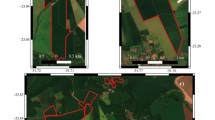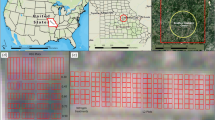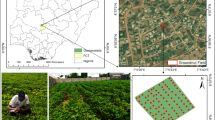Abstract
Prediction of isoflavone content in soybeans with Sentinel-2 of optical sensor data by means of regressive analysis is conducted. There is strong demand on estimation of isoflavone content for soybeans famers because the isoflavone is good for health. Soy isoflavones are a component that is abundant in the germ of soybeans. Soy isoflavones have a structure similar to female hormone (estrogen) and are known to exhibit female hormone-like action. Namely, isoflavone supports joint movement; promotes bone metabolism; maintains walking ability. There is a possibility to estimate isoflavone content from space. That is to estimate isoflavone content through regressive analysis with NDVI derived from remote sensing satellite based optical sensor and truth data of isoflavone obtained by chemical measurements. If the isoflavone content can be estimated before harvest, then soy farmers may control fertilizer and water supply. Through experiments of isoflavone content estimation, it is found that the proposed method allows prediction of isoflavone content at three weeks before harvest.
Access this chapter
Tax calculation will be finalised at checkout
Purchases are for personal use only
Similar content being viewed by others
References
Afandi, S.D., Herdiyeni, Y., Prasetyo, L.B., Hashi, W., Arai, K., Okumura, H.: Nitrogen Content Estimation of rice Crop Basedon Near Infrared (NIR) reflectance Using Artificial Neural Network (ANN). Procedia Environ. Sci. 33, 63–69 (2016)
Arai, K., Shigetomi, O., Miura, Y., Munemoto, H.: Rice crop field monitoring system with radio-controlled helicopter based near infrared cameras through nitrogen content estimation and its distribution monitoring. Int. J. Adv. Res. Artif. Intell. 2(3), 26–37 (2013)
Arai, K.: Rice crop quality evaluation method through regressive analysis between nitrogen content and near infrared reflectance of rice leaves measured from near field radio-controlled helicopter. Int. J. Adv. Res. Artif. Intell. 2(5), 1–6 (2013)
Arai, K., Sakashita, M., Shigetomi, O., Miura, Y.: Estimation of protein content in rice crop and nitrogen content in rice leaves through regressive analysis with NDVI derived from camera mounted radio-control helicopter. Int. J. Adv. Res. Artif. Intell. 3(3), 7–14 (2014)
Arai, K., Sakashita, M., Shigetomi, O., Miura, Y.: Relation between rice crop quality (protein content) and fertilizer amount as well as rice stump density derived from helicopter data. Int. J. Adv. Res. Artif. Intell. 4(7), 29–34 (2015)
Arai, K., Sakashita, M., Shigetomi, O., Miura, Y.: Estimation of rice crop quality and harvest amount from helicopter mounted NIR camera data and remote sensing satellite data. Int. J. Adv. Res. Artif. Intell. 4(10), 16–22 (2015)
Arai, K.: Gondoh, Miura, Shigetomi, Effect of stump density, fertilizer on rice crop quality and harvest amount in 2015 investigated with drone mounted NIR camera data. Int. J. Eng. Sci. Res. Technol. 2(2), 1–7 (2016)
Arai, K., Gondoh, K., Shigetomi, O., Miura, Y.: Method for NIR reflectance estimation with visible camera data based on regression for NDVI estimation and its application for insect damage detection of rice paddy fields. Int. J. Adv. Res. Artif. Intell. 5(11), 17–22 (2016)
Arai, K., Shigetomi, O., Miura, Y.: Artificial intelligence based fertilizer control for improvement of rice quality and harvest amount. Int. J. Adv. Comput. Sci. Appl. IJACSA 9(10), 61–67 (2018)
Arai, K.: Method for Vigor Diagonosis of tea trees based on nitrogen content in tealeaves relating to NDVI. Int. J. Adv. Res. Artif. Intell. 5(10), 24–30 (2016)
Arai, K., Shigetomi, O., Miura, Y., Yatsuda, S.: Smartphone image based agricultural product quality and harvest amount prediction method. Int. J. Adv. Comput. Sci. Appl. IJACSA 10(9), 24–29 (2019)
Acknowledgment
The authors would like to thank to Professor Dr. Hiroshi Okumura and Professor Dr. Osamu Fukuda for their valuable discussions.
Author information
Authors and Affiliations
Corresponding author
Editor information
Editors and Affiliations
Rights and permissions
Copyright information
© 2022 The Author(s), under exclusive license to Springer Nature Switzerland AG
About this paper
Cite this paper
Arai, K., Shigetomi, O., Ohtsubo, H., Ohya, E. (2022). Prediction of Isoflavone Content in Soybeans with Sentinel-2 Optical Sensor Data by Means of Regressive Analysis. In: Arai, K. (eds) Intelligent Systems and Applications. IntelliSys 2021. Lecture Notes in Networks and Systems, vol 296. Springer, Cham. https://doi.org/10.1007/978-3-030-82199-9_58
Download citation
DOI: https://doi.org/10.1007/978-3-030-82199-9_58
Published:
Publisher Name: Springer, Cham
Print ISBN: 978-3-030-82198-2
Online ISBN: 978-3-030-82199-9
eBook Packages: Intelligent Technologies and RoboticsIntelligent Technologies and Robotics (R0)




